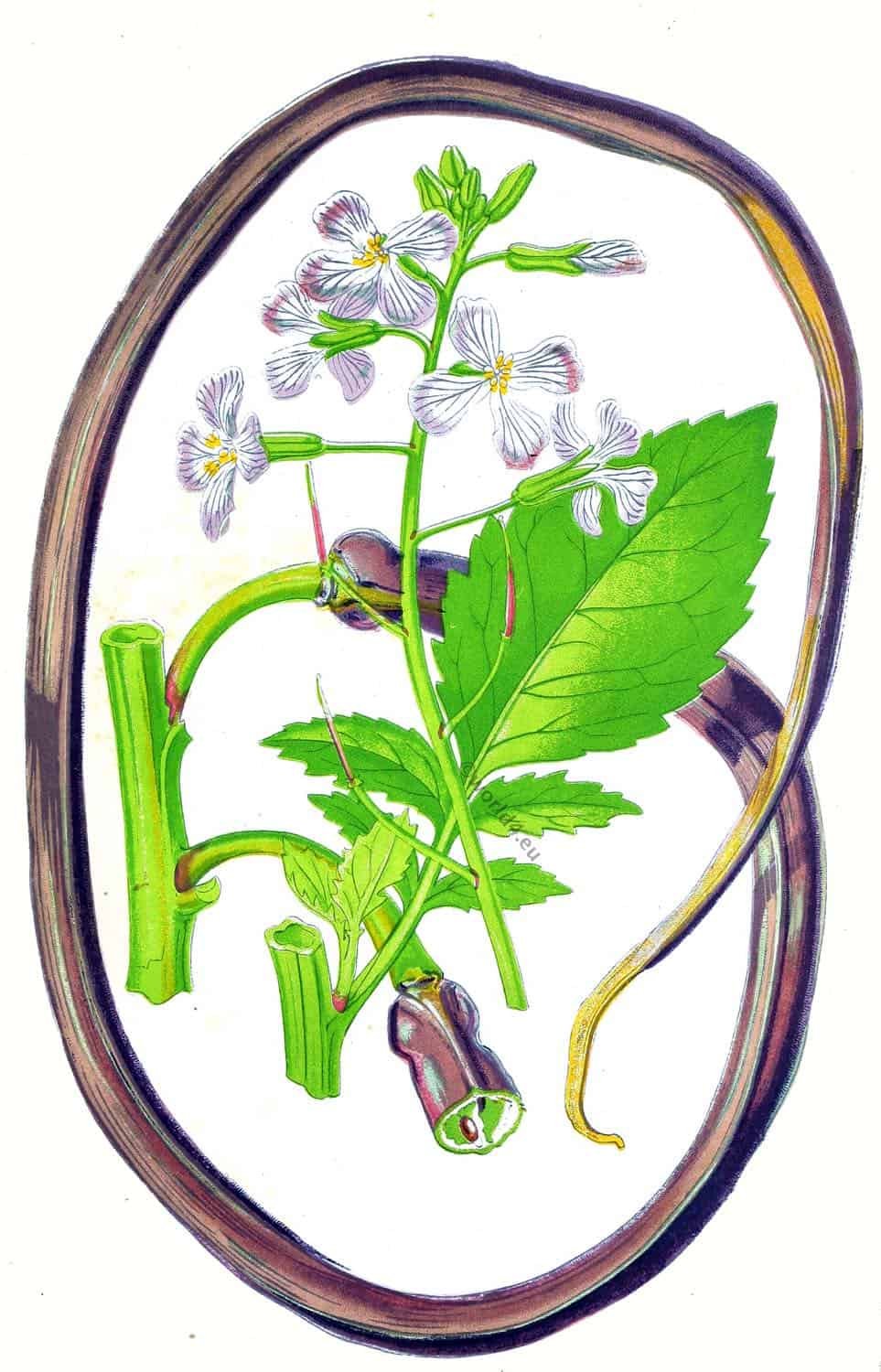
Raphanus caudatus. The rat-tail radish.
By J. R. Jackson, Royal Museum, Kew.
THE newly-introduced radish, which has attracted the attention of horticulturists so much of late, is certainly a novelty, inasmuch as the edible portion of the plant is the seed-vessel, and not the root. The common radish, in its numerous varieties, is such an exceedingly popular salad-plant, that we are scarcely prepared to look to this genus for new economic products or floral novelties.
When wo consider the many varieties of radish known in this country, from the long and tapering red-root to the white turnip-radish, we might, in some measure, be prepared for a wider development of nature’s laws in tropical countries. Of the genus Raphanus there are but six species, and two of these are British, namely, the wild radish or jointed charlock (R. raphanistrum), and the sea-radish (R. maritimus).
From whence our garden-radish came is unknown. It has been thought to be a native of China; but some varieties of R. raphanistrum have been gathered on the shores of the Mediterranean, and have characters almost sufficient to establish a link between the two, and the possibility of the one being- a cultivated form of the other.
The garden-radish, however, was very extensively grown both by the Egyptians and Greeks in ancient times, and has long- been in cultivation in this country. We read that radishes appeared at the table of Henry VIII., about 1532, and the author of “The Book of Simples,” written in 1562, says: “Of radish-roots there ho no small store growing about the famous Citye of London. They be more plentifull than profytable, and more noysome than nowrishinge to manne’s nature.” Old Gerard seems to have been acquainted with four varieties so early as 1597.
The effects of climatic changes and rich soil, together with careful cultivation, have considerably increased the number of varieties; but the result has been a greater or more perfect development of the root. This is not the case with the Raphanus caudatus; the pods are the edible as well as the most singular part of the plant, for they are said to grow to a length of three or four feet. The seeds of this radish, which have been recently advertised for sale at the very high price of one guinea for seven seeds, were first received at the Edinburgh Botanic Garden, in April, 1865, and the pods were exhibited in July of the same year.
The plant is said to be a native of India, whence the seeds were derived. They germinate, and the plants grow very rapidly; those at Edinburgh flowering seven weeks after sowing. The petals are whitish, tipped with purple, and traversed by purple veins, or streaks; each plant has from eighteen to twenty seed-vessels, some of them two feet nine inches long, and varying in colour from green to purple, or a mixture of the two. The plants grow well in the open air; indeed, they are said to do better even than under glass, those grown at Edinburgh and by Mr. Bull, of Chelsea, flowering- much more profusely out of doors, than those kept in a greenhouse or stove. The rapidity of the growth of the pod must be something remarkable, if, as alleged, it grows three inches in one night. These long fruits hang upon the plant ; some quite straight, while others are twisted and curled in all directions, giving- the plant a very peculiar appearance. The greatest twisting- or contortion of the seed-vessels occurs when the seeds are mostly in the upper portion of the siliqua.
Now the economic value of this plant lies entirely in these long seed vessels: they are said to be of a much more delicate flavor than a common esculent radish-root, with, perhaps, a little more pungency. They can be eaten raw, in their young state, as an ordinary radish, or in salads, or as pickle; indeed, if we are to believe the advertisements, these seed-vessels are to be “regarded as one of the most useful vegetables that have been introduced for many years.”
Now the question that arises regarding- this edible-podded radish is, whether it is a true and distinct species. Some eight years since, seeds were received in this country of a radish, called the Madras radish. It is said, however, to be a native of Java, but cultivated to some extent in India, especially in the vicinity of Benares.
This plant was also grown at the Edinburgh Botanic Garden; but, instead of pods three or four feet long, it only produced them of eight or nine inches. This radish was subsequently called the rat-tail radish, of which many varieties are known, and though the pods produced at Edinburgh were not more than nine inches in length, it would appear that, by carefully sowing seed from the long- attenuate-podded plants, they can be grown much longer.
The pods of the Madras, or rat-tail radish, are referred to as being edible, though they never came into great repute. The question now to be decided is, whether these two plants are identical, and to be considered rather as varieties than as species. Professor Balfour says,’ the two plants he has at Edinburgh still hold good to their distinctive characters. Those who consider them quite distinct have given the name of snake-radish to the longest podded one, to distinguish it from the rat-tail.
We are informed that on the plant arriving- at maturity, the pods of Raphatius C. are often so numerous and heavy, as to render a substantial support to the plant necessary, in order to prevent its branches from being broken. When served as a cooked vegetable, it should be treated after the manner of asparagus, which in taste it is said much to resemble. The flavour of early green peas which is attributed to it, will no doubt by epicures be deemed no disqualification or loss of claim to their I favorable consideration. — E d.
Source: Nature and art. London: Day & Son, 1866-1867.
Related
Discover more from World4 Costume Culture History
Subscribe to get the latest posts sent to your email.







